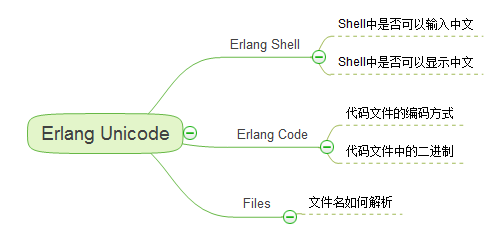最近看了Erlang User Conference 2013上patrik分享的BRING UNICODE TO ERLANG!视频,这个分享很好的梳理了Erlang Unicode相关的问题,基本上把 Using Unicode in Erlang 讲解了一遍.再次学习了一下,整理成文字,补充一些 [Erlang 0062] Erlang Unicode 两三事 遗漏掉的内容.
视频在这里: http://www.youtube.com/watch?v=M6hPLCA0F-Y
PDF在这里: http://www.erlang-factory.com/upload/presentations/847/PatrikEUC2013.pdf
演变

问题域
我们梳理一下,Erlang Unicode的问题域包含哪些具体的细节:
Erlang Shell
Erlang Shell中是否可以输入中文
Erlang Shell中是否可以显示中文
Erlang Code
代码文件的编码方式
Files
文件名如何解析

下面我们逐一击破:
Erlang Shell中是否可以输入中文
1 2 | # echo $LANGen_US.UTF-8 |
1 | LC_CTYPE=en_US.ISO-8859-1 /usr/local/bin/erl |
1 2 3 4 5 6 7 8 9 10 11 12 13 14 15 16 17 | LC_CTYPE=en_US.ISO-8859-1 /usr/local/bin/erlErlang R16B02 (erts-5.10.3) [source] [64-bit] [smp:2:2] [async-threads:10] [hipe] [kernel-poll:false]Eshell V5.10.3 (abort with ^G)1> io:getopts().[{expand_fun,#Fun<group.0.56199974>},{echo,true},{binary,false},{encoding,latin1}]2> "210\221[C.[230,136,145,228,187,172]3> io:setopts([{encoding,unicode}]). ok4> 4> "我们".[25105,20204]5> |
1 2 3 4 5 6 7 8 9 10 11 12 13 14 15 16 17 18 19 20 21 22 23 24 25 26 27 28 29 30 | Erlang/OTP 17 [erts-6.0] [source] [64-bit] [smp:4:4] [async-threads:10] [hipe] [kernel-poll:false]Eshell V6.0 (abort with ^G)1> "我们"."我们"2> io:format("~tp",[v(1)])."我们"ok4> io:format("~ts",[v(1)]).我们ok5> io:format("~ts",[lists:seq(20204,20220)]).们仭仮仯仰仱仲仳仴仵件价仸仹仺任仼ok6> io:format("~ts",[lists:seq(20204,20290)]).们仭仮仯仰仱仲仳仴仵件价仸仹仺任仼份仾仿伀企伂伃伄伅伆伇伈伉伊伋伌伍伎伏伐休伒伓伔伕伖众优伙会伛伜伝伞伟传伡伢伣伤伥伦伧伨伩伪伫伬伭伮伯估伱伲伳伴伵伶伷伸伹伺伻似伽伾伿佀佁佂ok7> io:getopts().[{expand_fun,#Fun<group.0.100149429>},{echo,true},{binary,false},{encoding,unicode}]8> io:setopts([{encoding,latin1}]).ok9> io:format("~ts",[lists:seq(20204,20290)]).\x{4EEC}\x{4EED}\x{4EEE}\x{4EEF}\x{4EF0}\x{4EF1}\x{4EF2}\x{4EF3}\x{4EF4}\x{4EF5}\x{4EF6}\x{4EF7}\x{4EF8}\x{4EF9}\x{4EFA}\x{4EFB}\x{4EFC}\x{4EFD}\x{4EFE}\x{4EFF}\x{4F00}\x{4F01}\x{4F02}\x{4F03}\x{4F04}\x{4F05}\x{4F06}\x{4F07}\x{4F08}\x{4F09}\x{4F0A}\x{4F0B}\x{4F0C}\x{4F0D}\x{4F0E}\x{4F0F}\x{4F10}\x{4F11}\x{4F12}\x{4F13}\x{4F14}\x{4F15}\x{4F16}\x{4F17}\x{4F18}\x{4F19}\x{4F1A}\x{4F1B}\x{4F1C}\x{4F1D}\x{4F1E}\x{4F1F}\x{4F20}\x{4F21}\x{4F22}\x{4F23}\x{4F24}\x{4F25}\x{4F26}\x{4F27}\x{4F28}\x{4F29}\x{4F2A}\x{4F2B}\x{4F2C}\x{4F2D}\x{4F2E}\x{4F2F}\x{4F30}\x{4F31}\x{4F32}\x{4F33}\x{4F34}\x{4F35}\x{4F36}\x{4F37}\x{4F38}\x{4F39}\x{4F3A}\x{4F3B}\x{4F3C}\x{4F3D}\x{4F3E}\x{4F3F}\x{4F40}\x{4F41}\x{4F42}ok10> io:format("~ts",[v(1)]). \x{6211}\x{4EEC}ok11> io:setopts([{encoding,unicode}]). ok12> io:format("~ts",[v(1)]). 我们ok13> io:format("~ts",[lists:seq(20204,20290)]).们仭仮仯仰仱仲仳仴仵件价仸仹仺任仼份仾仿伀企伂伃伄伅伆伇伈伉伊伋伌伍伎伏伐休伒伓伔伕伖众优伙会伛伜伝伞伟传伡伢伣伤伥伦伧伨伩伪伫伬伭伮伯估伱伲伳伴伵伶伷伸伹伺伻似伽伾伿佀佁佂ok14> |
Erlang Shell中是否可以显示中文
之前提到过的Erlang Shell 中显示文本常量的各种奇怪,其实源于字符串启发式检测机制("Heuristic String Detection"),简单讲就是Erlang Shell会检测List,Binary里面的数据是否可以有可打印的字符,比如下面的二进制串<<230,136,145,228,187,172,229,173,166,228,185,160>>.就被认为检测到可打印的,就输出了<<"我们学习"/utf8>>.
还记得那个输出数据的技巧吗?输出的数据内容被Shell自作聪明的打印成了字符,怎么解决的呢?在数据尾部追加一个0,比如[25105].会打印出来"我",[25105,0]就原样输出了.这个技巧实际上是通过加0避开了"Heuristic String Detection"机制.做下面的实验需要注意的一点是启动erl的参数:
1 | erl +pc unicode |
+pc 这个选项的作用就是选择Shell可打印字符的范围,可以是erl +pc latin1 或者 erl +pc unicode,在紧接着的实验里面,[25105]被如实显示并没有被解析显示成"我".
默认情况下,erl启动参数是latin
1 2 3 4 5 6 7 8 9 10 11 12 13 14 15 16 | # erl +pc unicodeErlang/OTP 17 [erts-6.0] [source] [64-bit] [smp:2:2] [async-threads:10] [hipe] [kernel-poll:false]Eshell V6.0 (abort with ^G)1> <<230,136,145,228,187,172,229,173,166,228,185,160>>.<<"我们学习"/utf8>>2> <<230,136,145,228,187,172,229,173,166,228,185,160,69,114,108,97,110,103>>.<<"我们学习Erlang"/utf8>>3> $我.251054> <<230,136,145,228,187,172,229,173,166,228,185,160,69,114,108,97,110,103,0>>.<<230,136,145,228,187,172,229,173,166,228,185,160,69,114, 108,97,110,103,0>>5> [25105]."我"6> [25105,0].[25105,0] |
1 2 3 4 5 6 7 8 | # erlErlang/OTP 17 [erts-6.0] [source] [64-bit] [smp:2:2] [async-threads:10] [hipe] [kernel-poll:false]Eshell V6.0 (abort with ^G)1> $我.251052> [25105].[25105]3> |
io:printable_range/0 和 io_lib:printable_list/1这两个函数可以帮助我们检查当前shell的可打印字符的范围,判断一个List是否属于可打印的.看下面的例子:
1 2 3 4 5 6 7 8 9 10 | erl +pc unicodeErlang/OTP 17 [erts-6.0] [source] [64-bit] [smp:2:2] [async-threads:10] [hipe] [kernel-poll:false]Eshell V6.0 (abort with ^G)1> io_lib:printable_list([25105,20204]).true2> [25105,20204]."我们"3> io:printable_range().unicode4> |
1 2 3 4 5 6 7 8 9 10 | erlErlang/OTP 17 [erts-6.0] [source] [64-bit] [smp:2:2] [async-threads:10] [hipe] [kernel-poll:false]Eshell V6.0 (abort with ^G)1> io_lib:printable_list([25105,20204]).false2> [25105,20204].[25105,20204]3> io:printable_range().latin14> |
这个启发机制(heuristics)同样被io(_lib):format/2使用,~tp会受到+pc参数的影响,~ts不会.
1 2 3 4 5 6 7 8 9 10 11 12 13 14 15 16 17 18 19 20 21 22 23 | # erl +pc unicode 7> io:format("~ts",[[25105]]).我ok8> io:format("~tp",[[25105]])."我"ok9> # erl +pc latin1 3> io:format("~ts",[[25105]]).我ok4> io:format("~tp",[[25105]]).[25105]ok5> |
代码文件的编码方式
1 2 3 4 | -module(coding).-compile(export_all).a()-> "我们学习Erlang". |
1 2 3 4 5 6 7 8 9 | Erlang/OTP 17 [erts-6.0] [source] [64-bit] [smp:2:2] [async-threads:10] [hipe] [kernel-poll:false]Eshell V6.0 (abort with ^G)1> coding:a().[25105,20204,23398,20064,69,114,108,97,110,103]2> io:format("~ts",[v(1)]).我们学习Erlangok3> q().ok4> |
1 2 3 4 5 6 7 8 9 | Erlang R16B02 (erts-5.10.3) [source] [64-bit] [smp:2:2] [async-threads:10] [hipe] [kernel-poll:false]Eshell V5.10.3 (abort with ^G)1> coding:a().[230,136,145,228,187,172,229,173,166,228,185,160,69,114,108,97,110,103]2> io:format("~ts",[v(1)]).æ们å¦ä¹ Erlangok3> |
1 2 3 4 5 | %% -*- coding: utf-8 -*--module(coding).-compile(export_all).a()-> "我们学习Erlang". |
下面我们在之前的测试代码文件中添加一个方法,返回一个二进制序列:
1 2 | b()-> <<"我们学习Erlang">>. |
1 2 3 4 5 6 7 8 9 | # /usr/local/bin/erlErlang R16B02 (erts-5.10.3) [source] [64-bit] [smp:2:2] [async-threads:10] [hipe] [kernel-poll:false]Eshell V5.10.3 (abort with ^G)1> coding:b().<<17,236,102,96,69,114,108,97,110,103>>2> io:format("~ts",[v(1)]).^Qìf`Erlangok3> q().ok |
你可能会猜测是+pc unicode的原因吗?好吧,明知不是我们还是试一下:
1 2 3 4 5 6 7 8 9 10 | # /usr/local/bin/erl +pc unicodeErlang R16B02 (erts-5.10.3) [source] [64-bit] [smp:2:2] [async-threads:10] [hipe] [kernel-poll:false]Eshell V5.10.3 (abort with ^G)1> coding:b().<<17,236,102,96,69,114,108,97,110,103>>2> io:format("~ts",[v(1)]).^Qìf`Erlangok3> q().ok |
问题在什么地方?对utf8描述符
1 2 3 4 | b()-> <<"我们学习Erlang"/utf8>>. |
1 2 3 4 5 6 7 8 9 10 11 | # /usr/local/bin/erlErlang R16B02 (erts-5.10.3) [source] [64-bit] [smp:2:2] [async-threads:10] [hipe] [kernel-poll:false]Eshell V5.10.3 (abort with ^G)1> coding:b().<<230,136,145,228,187,172,229,173,166,228,185,160,69,114, 108,97,110,103>>2> io:format("~ts",[v(1)]).我们学习Erlangok3> |
做下简单的实验看看这两者的区别:
1 2 3 4 5 6 7 8 9 10 11 12 13 14 | erlErlang/OTP 17 [erts-6.0] [source] [64-bit] [smp:2:2] [async-threads:10] [hipe] [kernel-poll:false]Eshell V6.0 (abort with ^G)1> "αβ" .[945,946]2>2> <<"αβ">> .<<"±²">>3>3> <<"αβ"/utf8>> .<<206,177,206,178>>5> <<177,178>>.<<"±²">> |
上面的第2行测试代码是怎么回事呢?输出的是个什么东西呢?看一下第5行代码就可以了,输出的是<<177,178>>,换句话说数据被截断了.
文件名如何解析
至于文件名是否包含unicode,除非是文件名是不可控的外部资源,否则这个问题是可以通过项目规约规避掉的,没有必要通过代码/技术手段解决这个问题.
erl启动的时候添加不同的flag可以控制解析文件名的方式: +fnl 按照latin去解析文件名 +fnu 按照unicode解析文件名 +fna 是根据环境变量自动选择,这也是目前的系统默认值.可以使用file:native_name_encoding检查此参数.
1 2 3 4 5 6 7 8 9 | Eshell V5.10.3 (abort with ^G)1> file:native_name_encoding().latin12> Eshell V6.0 (abort with ^G)1> file:native_name_encoding().utf82> |
最后
unicode,io,file,group,user,re,wx,string这些模块在遇到unicode的时候要特别注意下.应该有不少人在正则这里栽跟头了吧, Using Unicode in Erlang 文档信息量很大,最后还有一些常见问题的解决以及代码,有兴趣的可以动手实践一下,今天就到这里.
2014-9-5 17:39:33 知乎上有一个问题 "使用 Erlang 时应如何处理 Unicode?" http://www.zhihu.com/question/25112531
问题聚焦的点其实就是文档里面的这几句:
http://www.erlang.org/doc/apps/stdlib/unicode_usage.html
The languageHaving the source code in UTF-8 also allows you to write string literals containing Unicode characters with code points > 255, although atoms, module names and function names will be restricted to the ISO-Latin-1 range until the Erlang/OTP 18.0 release. Binary literals where you use the /utf8 type, can also be expressed using Unicode characters > 255. Having module names using characters other than 7-bit ASCII can cause trouble on operating systems with inconsistent file naming schemes, and might also hurt portability, so it's not really recommended. It is suggested in EEP 40 that the language should also allow for Unicode characters > 255 in variable names. Whether to implement that EEP or not is yet to be decided.
为什么不在知乎回答问题?见下图,我买房选的都是2002,会为了一个网站做出让步?








【推荐】国内首个AI IDE,深度理解中文开发场景,立即下载体验Trae
【推荐】编程新体验,更懂你的AI,立即体验豆包MarsCode编程助手
【推荐】抖音旗下AI助手豆包,你的智能百科全书,全免费不限次数
【推荐】轻量又高性能的 SSH 工具 IShell:AI 加持,快人一步